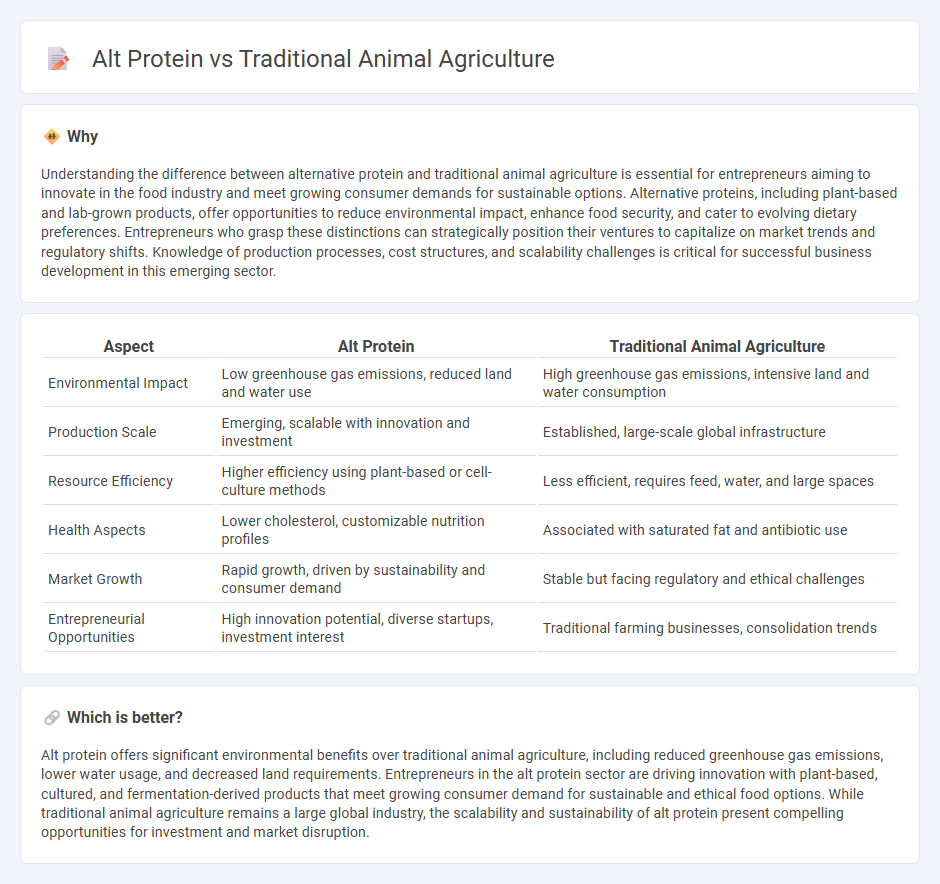
Entrepreneurship in alternative protein focuses on developing sustainable, plant-based, or cultured meat products to address environmental concerns and resource inefficiencies linked to traditional animal agriculture, which contributes significantly to greenhouse gas emissions and land use. Innovators leverage biotechnology and food science to create scalable, nutritious alternatives that meet consumer demand for ethical and eco-friendly options. Explore how startups are transforming the future of food and reshaping global agricultural practices.
Why it is important
Understanding the difference between alternative protein and traditional animal agriculture is essential for entrepreneurs aiming to innovate in the food industry and meet growing consumer demands for sustainable options. Alternative proteins, including plant-based and lab-grown products, offer opportunities to reduce environmental impact, enhance food security, and cater to evolving dietary preferences. Entrepreneurs who grasp these distinctions can strategically position their ventures to capitalize on market trends and regulatory shifts. Knowledge of production processes, cost structures, and scalability challenges is critical for successful business development in this emerging sector.
Comparison Table
| Aspect | Alt Protein | Traditional Animal Agriculture |
|---|---|---|
| Environmental Impact | Low greenhouse gas emissions, reduced land and water use | High greenhouse gas emissions, intensive land and water consumption |
| Production Scale | Emerging, scalable with innovation and investment | Established, large-scale global infrastructure |
| Resource Efficiency | Higher efficiency using plant-based or cell-culture methods | Less efficient, requires feed, water, and large spaces |
| Health Aspects | Lower cholesterol, customizable nutrition profiles | Associated with saturated fat and antibiotic use |
| Market Growth | Rapid growth, driven by sustainability and consumer demand | Stable but facing regulatory and ethical challenges |
| Entrepreneurial Opportunities | High innovation potential, diverse startups, investment interest | Traditional farming businesses, consolidation trends |
Which is better?
Alt protein offers significant environmental benefits over traditional animal agriculture, including reduced greenhouse gas emissions, lower water usage, and decreased land requirements. Entrepreneurs in the alt protein sector are driving innovation with plant-based, cultured, and fermentation-derived products that meet growing consumer demand for sustainable and ethical food options. While traditional animal agriculture remains a large global industry, the scalability and sustainability of alt protein present compelling opportunities for investment and market disruption.
Connection
The rise of alternative protein sources, such as plant-based and cell-cultured products, is transforming traditional animal agriculture by addressing sustainability, ethical concerns, and consumer demand for healthier options. Entrepreneurs in the alt protein space leverage advancements in biotechnology to create products that mimic conventional meat, impacting supply chains and market dynamics within the livestock industry. This intersection drives innovation, investment opportunities, and shifts in agricultural practices aiming to reduce environmental impact and enhance food security.
Key Terms
Livestock Farming
Livestock farming in traditional animal agriculture involves raising cattle, pigs, and poultry for meat, dairy, and eggs, contributing significantly to greenhouse gas emissions, land degradation, and water consumption. Alternative protein sources, such as plant-based meats, cultured meat, and fermentation-derived proteins, offer sustainable solutions that reduce environmental impact and improve resource efficiency. Explore how innovations in livestock farming and alternative proteins are transforming the future of food production.
Plant-Based Protein
Traditional animal agriculture consumes significant water and land resources while producing high greenhouse gas emissions, contributing substantially to environmental degradation. Plant-based protein alternatives offer a more sustainable solution by utilizing fewer resources and reducing carbon footprints without compromising nutritional value. Explore the benefits and innovations in plant-based proteins to understand their role in shaping a sustainable food future.
Cellular Agriculture
Traditional animal agriculture relies heavily on large-scale livestock farming, resulting in significant greenhouse gas emissions, land use, and water consumption. Cellular agriculture, a key segment of alternative protein production, uses cell culturing techniques to grow animal cells in controlled environments, drastically reducing environmental impact and ethical concerns associated with conventional farming. Explore the advancements in cellular agriculture to understand its potential to revolutionize protein production and sustainability.
Source and External Links
Animal husbandry - Wikipedia - Traditional animal agriculture, or animal husbandry, involves raising animals like cattle, sheep, goats, and poultry for meat, fiber, milk, and other products, often with historical practices including free grazing and use of animals for labor in ancient civilizations.
A History of Meat-Eating - Part 2: Traditional Agriculture - Traditional animal agriculture began around 11,000 years ago with the domestication of sheep and goats in Southwest Asia, providing stable sources of meat and wool and representing a shift from hunting to farming.
Traditional technologies for animal production - Traditional animal agriculture often includes low-input systems with animals kept in mixed farming environments, involving natural resistance to diseases, grazing, tethering, or zero grazing with feeding brought to animals and dung collected for use.
 dowidth.com
dowidth.com